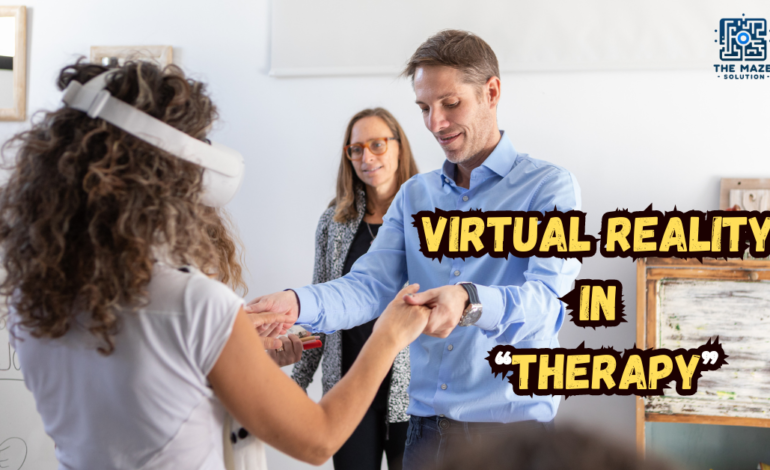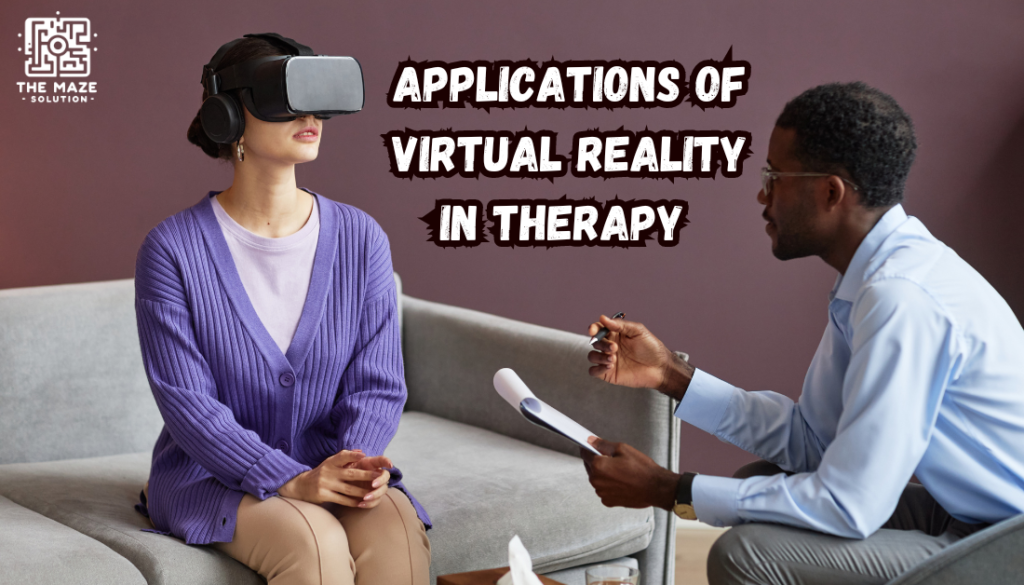Virtual Reality in Therapy: Benefits, Applications, and the Future of Mental Health Treatment

Introduction
Overview of Virtual Reality in Therapy
Virtual reality (VR) is no longer just for gaming or entertainment; it has expanded into fields as varied as education, military training, and healthcare. Among these, its role in mental health therapy is garnering significant attention, offering new ways to engage with patients and tailor treatment plans. This blog will explore how virtual reality in therapy is transforming mental health treatment, making it more accessible and effective for a wide range of individuals.
The Evolution of VR in Therapy
Virtual reality’s evolution in therapy has been nothing short of remarkable. Initially viewed as experimental, VR technology is now becoming more mainstream, with applications spanning from exposure therapy to cognitive rehabilitation. This transition has been fueled by technological advancements and growing interest from healthcare professionals eager to improve patient outcomes. The use of VR in therapy has shifted from being a futuristic concept to a practical tool employed by therapists worldwide.
Understanding Virtual Reality in Therapy
What is Virtual Reality in Therapy?
Virtual Reality in therapy is an innovative approach that leverages advanced computer-generated simulations to create immersive, interactive environments where therapeutic interventions can take place. This technology allows therapists to design and control a variety of scenarios that can be specifically tailored to the needs of each patient, offering a highly personalized form of treatment.
Immersive Therapeutic Environments
At the core of Virtual Reality in therapy is the creation of a virtual environment that mimics real-life situations. These environments are crafted using sophisticated software that generates realistic visuals, sounds, and sometimes even tactile sensations. Patients, equipped with VR headsets and controllers, are fully immersed in these virtual worlds, allowing them to engage with the environment as if it were real.
For example, a patient with social anxiety might be placed in a simulated social setting where they can practice interactions without the fear of real-world consequences. Similarly, a person with a phobia of heights might gradually confront their fear by virtually standing on increasingly higher platforms, all within the safe confines of a therapist’s office.
Tailored Therapeutic Experiences
One of the key advantages of Virtual Reality in therapy is its ability to offer tailored experiences. Unlike traditional therapy methods, where therapists must rely on verbal descriptions or imagination exercises, VR can precisely replicate scenarios that are difficult to create in the real world. This tailoring is particularly beneficial for exposure therapy, where the gradual and controlled exposure to a feared stimulus is crucial.
Therapists can adjust the complexity and intensity of the VR scenarios based on the patient’s progress, making the treatment adaptable and responsive to individual needs. This level of customization ensures that patients are neither overwhelmed nor under-challenged, striking the right balance for effective therapy.
Enhancing Engagement and Realism
Virtual Reality in therapy offers a multi-sensory experience that goes beyond traditional therapeutic methods. The combination of visual and auditory stimuli creates a more engaging and realistic environment. In some advanced setups, haptic feedback (tactile sensations) is also incorporated, allowing patients to “feel” their virtual surroundings, further enhancing the sense of presence in the virtual world.
This heightened realism can lead to more effective therapy sessions. Patients are often more engaged and motivated when the therapy feels real, which can lead to better outcomes. For instance, practicing public speaking in a virtual auditorium filled with avatars can be far more effective than simply imagining the scenario, as the visual and auditory cues provided by VR make the experience more authentic.
Applications Across Various Therapeutic Areas
The versatility of Virtual Reality in therapy makes it applicable across a wide range of therapeutic areas. It is being used for cognitive-behavioral therapy (CBT), where patients can practice coping strategies in simulated environments. For chronic pain management, VR can distract patients from their pain by immersing them in calming or engaging virtual worlds. In physical rehabilitation, patients can perform exercises in a motivating and interactive virtual setting, which can make the rehabilitation process less monotonous and more effective.
In conclusion, Virtual Reality in therapy represents a significant advancement in the field of mental health and rehabilitation. Its ability to create realistic, controlled, and engaging environments opens up new possibilities for treatment, offering patients a unique and potentially more effective therapeutic experience.
The Science Behind VR in Therapy
The effectiveness of virtual reality in therapy lies in its ability to influence the brain and psychological processes. Research has shown that VR can activate neural pathways associated with real-life experiences, helping patients process emotions and memories more effectively. Studies supporting VR’s use in therapy highlight its potential to reduce symptoms of anxiety, depression, and PTSD by creating controlled scenarios where patients can safely explore their feelings and reactions.
Applications of Virtual Reality in Therapy

Virtual Reality in Mental Health Therapy
Virtual reality has found a home in mental health therapy, offering new avenues for treating conditions like anxiety, PTSD, and depression. By simulating environments that trigger these conditions, therapists can help patients build coping strategies in a safe, controlled setting. Case studies have demonstrated the success of VR in therapy, with patients showing significant improvements in their mental health after engaging in virtual reality sessions.
Physical Rehabilitation and VR
Beyond mental health, virtual reality is making waves in physical rehabilitation. Patients recovering from injuries or disabilities can benefit from VR-based exercises that mimic real-world movements, promoting muscle recovery and improving balance. VR in therapy has been particularly effective for stroke victims and those with neurological disorders, providing engaging and motivating rehabilitation experiences that traditional methods often lack.
VR in Cognitive Behavioral Therapy (CBT)
Cognitive Behavioral Therapy (CBT) has embraced virtual reality as a tool for modifying harmful behaviors and thought patterns. By placing patients in virtual scenarios that replicate real-life challenges, therapists can guide them through CBT techniques in real-time. This approach enhances the effectiveness of therapy by allowing patients to practice new skills in a controlled environment, ultimately leading to more lasting behavioral changes.
Benefits of Virtual Reality in Therapy
Enhanced Engagement and Motivation
One of the primary benefits of virtual reality in therapy is the heightened level of engagement it offers. Patients often find VR sessions more enjoyable and less intimidating than traditional therapy, leading to increased motivation and participation. The immersive nature of VR helps capture and maintain the patient’s attention, making therapeutic activities feel more like real-world experiences rather than clinical exercises.
Personalized Therapy Sessions
Virtual reality in therapy allows for highly personalized treatment sessions. Therapists can customize the virtual environment and exercises to align with each patient’s specific needs, ensuring a tailored approach that addresses unique challenges. This personalization leads to more effective therapy, as patients receive targeted interventions that resonate with their personal experiences and goals.
Accessibility and Convenience
Virtual reality is making mental health treatment more accessible and convenient than ever before. Teletherapy sessions using VR can reach patients who might otherwise face barriers to accessing traditional in-person therapy, such as geographic limitations or physical disabilities. By reducing the need for travel, virtual reality in therapy can bring mental health services to those who need them most, regardless of location.
Impacts of Virtual Reality in Therapy
Positive Impacts of VR in Therapy on Mental Health
The positive impacts of virtual reality in therapy are evident in improved patient recovery rates and overall mental health outcomes. Patients often report feeling more empowered and confident in managing their symptoms after participating in VR therapy. Long-term benefits include reduced symptoms of anxiety, depression, and PTSD, as patients continue to use the skills acquired during VR sessions in their daily lives.
Challenges and Ethical Considerations
While virtual reality in therapy offers numerous benefits, it also presents challenges and ethical considerations that must be addressed. Potential issues include the risk of exacerbating symptoms if not managed properly and ensuring patient privacy and data security. Therapists using VR must obtain informed consent and provide clear guidelines to ensure the safe and ethical use of this technology in therapy.
The Future of Virtual Reality in Therapy
Emerging Trends in VR Therapy
The future of virtual reality in therapy is bright, with emerging trends indicating further advancements in its application. Researchers are exploring new ways to integrate VR with biofeedback, allowing patients to gain real-time insights into their physiological responses. Additionally, developments in wearable technology may soon enable more immersive and interactive VR therapy sessions, enhancing the overall experience for patients.
Integration with Other Technologies
The integration of virtual reality with other technologies, such as artificial intelligence and machine learning, holds great promise for enhancing therapeutic outcomes. AI can personalize VR experiences even further by analyzing patient data and adapting the therapy accordingly. These integrations could lead to more precise interventions, optimizing the impacts of virtual reality in therapy for each individual.
Predictions for the Next Decade
Over the next decade, virtual reality in therapy is expected to become a standard practice in mental health treatment. As technology continues to advance and become more affordable, more therapists and healthcare providers will adopt VR as a valuable tool in their therapeutic arsenal. This shift will likely result in broader acceptance of VR therapy, leading to improved mental health outcomes on a global scale.
Conclusion
Recap of Key Points
In summary, virtual reality in therapy is revolutionizing the field of mental health treatment. The benefits of VR therapy are evident in enhanced patient engagement, personalized treatment plans, and increased accessibility to mental health services. Its applications span mental health therapy, physical rehabilitation, and cognitive behavioral therapy, showcasing its versatility and effectiveness.
Final Thoughts
To fully harness the potential of virtual reality in therapy, continued research and development are essential. Mental health professionals and tech enthusiasts alike must collaborate to refine and expand VR applications, ensuring ethical and effective use. By embracing virtual reality in therapy, we can advance mental health treatment, providing hope and healing to countless individuals worldwide.





